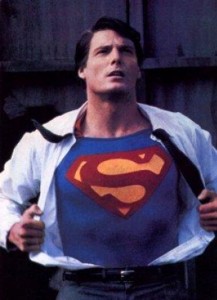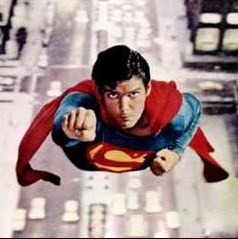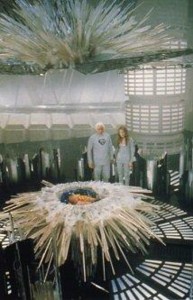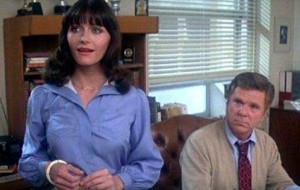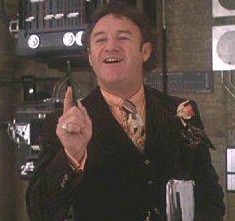| |
The Thunder ChildScience Fiction and Fantasy |
| |
|
|
The Superman Sourcebook by Ryan Brennan
To gain credibility, they hired The Godfather author Mario Puzo to pen the screenplay. Then they signed Marlon Brando for the then unheard of sum of $3.7 million for two weeks work. Gene Hackman was signed soon thereafter. These elements allowed the Salkinds to raise the funds necessary to finance the film. Originally, James Bond director Guy Hamilton was hired. When the production moved from the Continent to England, tax exile Hamilton had to drop out. Enter Richard Donner, known chiefly for the hit film The Omen. Donner signed on, not knowing that he was walking into a film where it would be necessary to discard every bit of the pre-production work done and start from scratch. Nor could he see that he would not finish for another 19 months. The Puzo script had been re-written by Robert Benton and Marilyn & David Newman. Donner brought in James Bond veteran Tom Mankiewicz as "creative consultant" to rewrite the script and bring it down to a reasonable length from its 500+ pages. Mankiewicz's contributions were such that Donner says he should have received a full writing credit. Before these big names signed on, nobody would talk to them about funding, not even banks that provided military loans with bad credit.
What audiences saw that Christmas season of 1978 was unlike any other comic book adaptation they had ever witnessed. Presented in 70mm and multi-track stereophonic sound, Superman opened with theater curtains parting to reveal an old-fashioned, nearly square movie screen. A title establishes the year as 1938. The image of an
Can you imagine what it was like to sit in the theater, tense to see how a beloved icon would be treated, and see the film open with that sequence? A commercial for military loans could have followed and nobody would have left their seats.
From here on many viewers were sold, awaiting only the first appearance of Superman himself to be fully convinced that the Caped Crusader had been done justice. And he had. The fable begins as many good fables begin, with a statement claiming that it is not a fable. Marlon Brando, the iconic actor taken as one of America's most serious and powerful performers, intones, "This is no fantasy, no product of wild imagination" for by now the camera has traveled through the vastness of space to the planet Krypton where Superman's father, Jor-el, conducts the trial of three criminals. These criminals, led by General Zod (Terence Stamp), are banished to the Phantom Zone, but will become more important in the second Superman film.
Many years pass, the future Superman absorbing knowledge from the lessons spoken to him by his father and mother. Eventually, his ship arrives on Earth where the farming couple, the Kents, discover the naked boy and adopt him as their own. The film makes a radical turn at this point, the wide open spaces, farm landscape and lush yellow fields of waving wheat emphasizing Superman's humble, All-American background and values. He is given the name Clark, and he is taught by his down-to-earth father (Glen Ford) to conceal his great powers and abilities.
Clark spots the peril and looks for a place to change into his Superman outfit. He passes a modern pay phone, the freestanding type on a pole with no booth, which produces a chuckle, and moves on to a revolving door where his speed produces a blur of colors that reveal Superman. He zooms convincingly into the sky, saving Lois and preventing the copter from falling.
There follows a series of vignettes in which Superman thwarts various criminal activity and performs civic duties (like getting a cat down out of a tree). And then it's time to introduce the villain. Gene Hackman took a chance with this role, his first outwardly comic turn, to play criminal genius Lex Luthor. Luthor's ego is such that he cannot tolerate the existence of someone who could so easily thwart his activities. To eliminate Superman, Luthor, in one of many logic-defying moments in the film, reasons that a piece of Superman's home planet will kill him. Further he deduces that a piece of Krypton must have fallen to Earth.
Luthor uses Superman's weakened state to inaugurate his master plan: By detonating a nuclear weapon along the San Andreas fault, he will cause Western California to drop into the ocean, making all of the desert real estate he owns enormously valuable. Luthor throws in a twist -- he is firing two missiles, one headed for the fault line, the other headed for the heavily populated Hackensack, New Jersey. Thanks to some help from Luthor's girl, Miss Teschmacher (Valerie Perrine), whose mother lives in Hackensack, Superman is back in the sky and racing to stop the NJ missile.
Meanwhile, Lois, always on the scent of a good story, happens to be right on top of the San Andreas fault. While Superman successfully diverts the NJ missile, he's too late to stop the one headed for the fault. The explosion causes earthquakes and cave-ins, one of which catches Lois' car, crushing it and burying Lois in dirt. Superman reaches her too late -- he had to save a small town from flooding when the quakes burst the dam -- but his sense of loss and outrage sends him at supersonic speeds in circles around the Earth, arresting and reversing its rotation. This reverses time and when Lois is once more safe again, Superman sets the Earth spinning correctly again.
Superman delivers Luthor and his dopey sidekick, Otis (Ned Beatty), to the penitentiary. Then it's up, up and away for the coda that ends all the films. As the sun rises over the rim of our planet, Superman cruises through the space over Earth, patrolling, ever watchful. As he speeds by the camera, he winks. Fear not, all is safe.
It is the perfection of this casting, and the chemistry between the two stars, that is central to the film's success. Whereas in the TV show the love interest between Clark/Lois/Superman was kept implicit, the feature films bring it out into the open and makes it a major plot point. Cast incorrectly, these scenes would not have played.
John Williams' score is a major asset. Coming as it did in a string of top assignments including Jaws (1975), Star Wars (1977), Close Encounter of the Third Kind (1977), The Empire Strikes Back (1980) and Raiders of the Lost Ark (1981), Williams became the preeminent film composer in the world. All of the other technical credits are top notch, too, from editor Stuart Baird, cinematographer Geoffrey Unsworth, to production designer John Barry. This one set the standard for the series: lush production values, top stars and lots of special effects.
Despite the accomplishments, in retrospect, Superman is a film that plays a bit better in the theater of the mind than on the television screen. The film is so well cast, we develop such affection for the characters, and the moments that work (which are many) are so entertaining, that we overlook the film's faults.
The opening sequence on Krypton is a bit long. The aerial ballet with Superman and Lois, in which Kidder voices the song, is a bit tedious. And even though the relationship between Lois and Clark is the emotional underpinning for the whole film, there nevertheless seems too much time devoted to it.
The film's ending is chaotic and unsatisfying. We want Superman to save Lois by getting there on time, not by reversing time. And, in the burst dam sequence, arguably the worst special effects appear, severely weakening the tension.
There are also lots of logic problems. Why would Superman allow Lois to fall during their flight? When Luthor tricks Superman into opening the box with the Kryptonite in it, why doesn't Superman just close the box again? When Superman runs into the revolving door, doesn't he worry that someone inside or outside will see him? Why are there two missiles? Luthor only needs two if Superman is alive, knowing that the Caped Crusader will go after the one heading for a populated area first. But Superman is supposedly dead at the bottom of the pool. And, of course, the reversal of time is a ridiculous notion, even in a comic book.
And how does he get his hands on not one but two nuclear missiles anyway? It's not like the military loans those things out to anyone who asks.
The special features on this Warner Bros. DVD are of interest. A commentary track features director Richard Donner and Tom Mankiewicz. The men are friends and their banter is easy and relaxed. When Mankiewicz says, "I think I overwrote," Donner replies, "What's new about that?" Some wasted verbiage of the "Isn't she adorable?" variety is present but in general they discuss all aspects of the shooting, revealing how effects were accomplished, who was in the running for roles, etc. They also discuss some of the story changes that occurred such as taking the ending for the second film and giving it to the first. There has been talk of releasing a Donner version of Superman II and based on their comments it would be interesting to see.
There are several featurettes dealing with the film's production. These are hosted by Marc McClure and several of the film's original production crew. Screen tests are included with Lesley Ann Warren, Holly Palance, Anne Archer, Susan Blakely and Debra Raffin. A couple of deleted scenes feature Otis feeding the "babies," Luthor's lion pit in which he plans to make Miss Teschmacher a meal after her betrayal.
This particular DVD edition is a restored version so does not exactly match either the original release or previous video versions. It includes several minutes of footage re-inserted by Donner including more footage of Krypton, a Luthor gauntlet of machine guns, fire, and ice, and cameos with Noel Neill and the first movie Superman Kirk Alyn.
|
Recommended Reading
|
All text © 2006 The Thunder Child unless otherwise credited.
All illustrations retain original copyright.
Please contact us with any concerns as to correct attribution.
Any questions, comments or concerns contact The Thunder Child.
